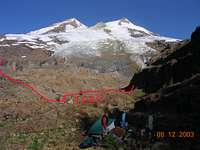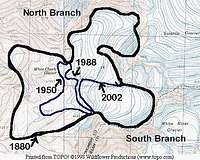Recent Glacier Terminus Behavior
Overview
In historic times, glaciers grew during the Little Ice Age, a cool period from about 1550 to 1850. Subsequently, until about 1940, glaciers around the world retreated as climate warmed. Glacier recession declined and reversed, in many cases, from 1950 to 1980 as a slight global cooling occurred. Since 1980, glacier retreat has become increasingly rapid and ubiquitous, so much so that it has threatened the existence of many of the glaciers of the world. This process has increased markedly since 1995, leading to such bizarre steps as covering sections of Austrian alpine glaciers with plastic to retard melting.
The recession of mountain glaciers, has been used to provide qualitative support to the rise in global temperatures since the late 19th century
[2]. Many glaciers are being lost to melting further raising concerns about future local water resources in these glacierized areas. Glaciers are the perfect summer water supply in alpine regions providing the highest runoff during warm dry periods when other water sources are at a minimum. The smaller the glacier area to melt, the less the runoff, the greater the change in alpine streamflow and the higher the stress on man and aquatic users of this resource. The Lewis Glacier, North Cascades pictured at right after melting away in 1990.
![User Profile Image]()
Glaciers respond to climate in an attempt to achieve equilibrium. A glacier advances due to a climate cooling/snowfall increase that causes positive mass balance. A climate warming/snowfall decrease leads to negative mass balances and glacier retreat. To reestablish equilibrium a retreating glacier must lose enough of its highest ablating sections, usually at the lowest elevations, so that accumulation in the accumulation zone once again balances ablation. If a glacier cannot retreat to a point where equilibrium is established, it is in disequilibrium with the climate system. A glacier that is in disequilibrium with present climate will melt away with a continuation of this climate.
North America
Cascade Range
The Cascade Range of western North America extends from southern British Columbia in Canada to northern California. Excepting Alaska, about half of the glacial area in the U.S. is contained in the more than 700 glaciers in the North Cascades, a portion of the range between the Canadian border and I-90 in central Washington. These glaciers store as much water as that contained in the lakes and reservoirs in the rest of the state and provide much of the stream and river flow in the dry summer months, some 870,000 m³. As recently as 1975, many North Cascade glaciers were advancing due to cooler/wet weather during the 1944-1976 period. However, by 1987, all North Cascade glaciers were retreating. However, since 1976 these glaciers have receded rapidly. Between 1984 and 2005, they have lost an average more than 9.5 m in thickness and 20 to 40% of their volume.
[10]. The Easton Glacier pictured at left has retreated 255 m since 1985.
This recession is widespread. All 47 monitored glaciers are receding and four have disappeared completely. The White Chuck Glacier (near Glacier Peak) is a particularly dramatic example. It shrank from 3.1 km2 in 1958 to 0.9 km2 in 2002. The Boulder Glacier on the southeast flank of Mount Baker retreated 450 m from 1987 to 2005 leaving unvegetated terrain behind. This retreat has occurred during a period of less winter snowfall and higher summer temperatures. Winter snowpack has declined 25% since 1946 and summer temperatures have risen 1.2 degrees Fahrenheit (0.7 °C) during the same period.
Four glaciers have been observed to disappear since 1985; Spider Glacier, Lewis Glacier, Milk Lake Glacier and DavidGlacier. Currently most North Cascade glaciers are in disequilibrium, meaning they cannot retreat to a point of new equilibrium and can only melt away with the present climate.
[11] [12]. Below right is a map of Whitechuck Glacier illustrating the change in area through time of this disappearing glacier. This glacier has lost 80% of its area in the last century. The result is less late summer runoff in the Whitechuck River.
Rocky Mountains
In the Canadian Rockies, the Athabasca Glacier, one of the outlet glaciers of the 325 km² Columbia Icefield, has retreated 1500 m since the late 19th century. This retreat has become more rapid after 1980, following a period of slow retreat from 1950-1980. The Peyto Glacier, covering an area of about 12 km², retreated rapidly during the first half of the 20th century, stabilized by 1966 and resumed shrinking in 1976.
[13] Illecillewaet Glacier in British Columbia's Glacier National Park (Canada) has retreated 2000 m since first photographed in 1887
On the sheltered slopes of the highest peaks of Glacier National Park, its eponymous glaciers are diminishing rapidly. The area of each glacier has been mapped by the National Park Service and the U.S. Geological Survey.
[14] Every glacier has retreated notably in the last 140 years. The larger glaciers are now approximately a third of their size when first studied in 1850, and numerous smaller glaciers have disappeared completely. Only 27 % of the 99 km² area of Glacier National Park covered by glaciers in 1850 remained by 1993. Average glacier area in the accumulation zone for September 1993 was 35%, 65% is needed for equilibrium, indicating negative mass balances for most glaciers and continued shrinkage.
An increase of approximately 1 degree Celsius (2 °F) in average summer temperatures is reflected in reduced glacier sizes. A computer model indicates that present rates of increasing warming will eliminate all glaciers in Glacier National Park by 2030. Even with no additional warming over that which has already occurred, the glaciers are likely to be gone by 2100.
The semiarid climate of Wyoming still manages to support about a dozen small glaciers within Grand Teton National Park which all show evidence of recession over the past 50 years. One of the more easily reached of the glaciers in the Park known as "Schoolroom Glacier" is expected to be gone in 25 years. Research between 1950 and 1999 demonstrated that the glaciers in Bridger-Teton National Forest and Shoshone National Forest in the Wind River Range shrank by over a third of their size over that period. Photographs indicate that the glaciers today are only half the size as when first photographed in the late 1890's. Research also indicates that the glacial retreat was proportionately greater in the 1990s than in any other decade of the last 100 years.
[16] Gannett Glacier, on the northeast slope of Gannett Peak, is the largest single glacier in the Rocky Mountains south of Canada. It has reportedly lost over 25 % of its volume since 1980 and 50 % since 1920. It appears the remaining glaciers in Wyoming will disappear by the middle of the 21st Century, if the current cliamte continue.
Alps
The World Glacier Monitoring Service reports on changes in the terminus position of glaciers from around the world every 5 years.
[4} The 1995-2000 Edition notes the frontal variations of glaciers across the Alps and in Switzerland, 103 of 110 glaciers examined are retreating. Similarly, in Austria 95 of 99 glaciers were retreating, in Italy all 69 observed glaciers were in retreat and in France all 6 were retreating. French glaciers experienced a sharp retreat in the years 1942-53 followed by advances up to 1980, then further retreat from 1982. As an example the Argentière Glacier and Blanc Glacier have receded by 1150 and 1400 meters respectively since 1870. The largest glacier Chamonix remember the Bossons Glacier coming almost as far as the road. It has lost 1200 meters in length. This shrinking is not without risks. Glacial lakes have formed at the foot of the Mer de Glace. The lakes are held behind moraine dams. If the natural dams that hold this meltwater back break, it could cause widespread flooding in the valley below. In 1892 the lake of the Glacier de Tête Rousse burst emptying some 200,000 m3 of water and killing 200 people in Saint Gervais. Ski areas in Austria have covered areas of the Stubai and Pitztal Glacier with plastic wrap to retard melting of the glaciers that their ski areas utilize. Since 1980, 20% of the area of Swiss glaciers has been lost. The Grosser Aletsch Glacier is the largest glacier in Switzerland and has retreated 2600 m since 1880. The rate of retreat has increased after 1980, with 800 m or 30% of the total retreat occuring in the last 25 years
[5]. In the Italian Alps the percentage of retreating glaciers has increased from 34% in 1980 to 96% in 1999.
[6]. Below are graphs of the percentage of retreating Swiss Glacier and Italian Glaciers from the respective nations Glacier Commissions.
External Links
Add External Links text here.














Comments
Post a Comment